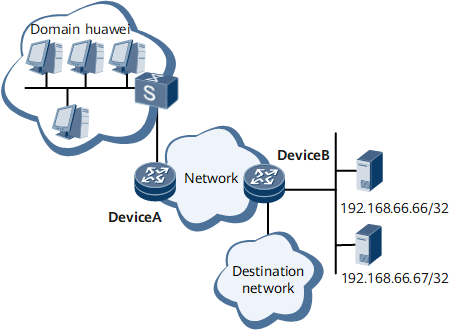Examples for Configuring Access User Authentication/Authorization/Accounting Based on the HWTACACS Protocol
The configuration examples refer to the applications of HWTACACS authentication/authorization/accounting on the actual network. The access users in the huawei domain use the HWTACACS to implement authentication/authorization/accounting.
Networking Requirements
As shown in Figure 1:
The access users are authenticated in local mode first. If the local authentication provides no response, the access users will be further authenticated by using the HWTACACS server.
After the level of an access user is promoted, the access user is authenticated by using the HWTACACS server first. If the HWTACACS authentication provides no response, the access user will be further authenticated in local mode.
The access users are authorized by using the HWTACACS server.
Accounting must be implemented for all users.
The HWTACACS server 192.168.66.66/32 is the primary server, with authentication port 49, authorization port 49, and accounting port 49. The HWTACACS server 192.168.66.67/32 is the secondary server, with authentication port 49, authorization port 49, and accounting port 49 by default.
Configuration Roadmap
Configure local and HWTACACS authentication/authorization/accounting as follows:
Configure the HWTACACS server template.
Configure the authentication scheme, the authorization scheme, and the accounting scheme.
Apply the HWTACACS server template, the authentication scheme, the authorization scheme, and the accounting scheme to the domain.
Data Preparation
To complete the configuration, you need the following data:
IP address of the primary (secondary) HWTACACS authentication server
IP address of the primary (secondary) HWTACACS authorization server
IP address of the primary (secondary) HWTACACS accounting server
Procedure
- Enable hwtacacs and configure the HWTACACS server template.
# Enable hwtacacs and configure the HWTACACS server template ht.
<HUAWEI> system-view [~HUAWEI] hwtacacs enable [*HUAWEI] hwtacacs-server template ht
# Configure the IP address and port number of the primary HWTACACS authentication/authorization/accounting server.
[*HUAWEI-hwtacacs-ht] hwtacacs-server authentication 192.168.66.66 49 [*HUAWEI-hwtacacs-ht] hwtacacs-server authorization 192.168.66.66 49 [*HUAWEI-hwtacacs-ht] hwtacacs-server accounting 192.168.66.66 49
# Configure the IP address and port number of the secondary HWTACACS authentication/authorization/accounting server.
[*HUAWEI-hwtacacs-ht] hwtacacs-server authentication 192.168.66.67 49 secondary [*HUAWEI-hwtacacs-ht] hwtacacs-server authorization 192.168.66.67 49 secondary [*HUAWEI-hwtacacs-ht] hwtacacs-server accounting 192.168.66.67 49 secondary
# Configure the key of the HWTACACS server.
[*HUAWEI-hwtacacs-ht] hwtacacs-server shared-key cipher it-is-my-secret123 [*HUAWEI-hwtacacs-ht] commit [~HUAWEI-hwtacacs-ht] quit
- Configure the authentication scheme, the authorization scheme, and the accounting scheme.
# Enter the AAA view.
[~HUAWEI] aaa
# Configure the authentication scheme 1-h. The authentication is first implemented in local mode and then in HWTACACS mode.
[~HUAWEI-aaa] authentication-scheme l-h [*HUAWEI-aaa-authen-l-h] authentication-mode local hwtacacs [*HUAWEI-aaa-authen-l-h] commit [*HUAWEI-aaa-authen-l-h] quit
# Configure the authorization scheme scheme2, with the authorization mode as HWTACACS.
[~HUAWEI-aaa] authorization-scheme scheme2 [*HUAWEI-aaa-author-scheme2] authorization-mode hwtacacs [*HUAWEI-aaa-author-scheme2] authorization-cmd hwtacacs [*HUAWEI-aaa-author-scheme2] commit [~HUAWEI-aaa-author-scheme2] quit
# Configure the accounting scheme scheme3, with the accounting mode as HWTACACS.
[~HUAWEI-aaa] accounting-scheme scheme3 [*HUAWEI-aaa-accounting-scheme3] accounting-mode hwtacacs [*HUAWEI-aaa-author-scheme3] commit [~HUAWEI-aaa-author-scheme3] quit
- Configure the huawei domain. Apply the HWTACACS authentication scheme l-h, the HWTACACS authorization scheme scheme2, the HWTACACS accounting scheme scheme3, and the HWTACACS template ht to the domain.
[~HUAWEI-aaa] domain huawei [*HUAWEI-aaa-domain-huawei] authentication-scheme l-h [*HUAWEI-aaa-domain-huawei] authorization-scheme scheme2 [*HUAWEI-aaa-domain-huawei] accounting-scheme scheme3 [*HUAWEI-aaa-domain-huawei] hwtacacs-server ht [*HUAWEI-aaa-domain-huawei] commit [~HUAWEI-aaa-domain-huawei] quit [~HUAWEI-aaa] quit
- Verify the configuration.
After running the display hwtacacs-server template command on the router, you can check whether the configuration of the template on the HWTACACS server matches the requirements.
<HUAWEI> display hwtacacs-server template ht ------------------------------------------------- Template Name : ht Template ID : 0 Primary Authentication Server : 192.168.66.66-49:- Primary Authorization Server : 192.168.66.66-49:- Primary Accounting Server : 192.168.66.66-49:- Primary Common Server : 192.168.66.66-49:- Current Authentication Server : 192.168.66.66-49:- Current Authorization Server : 192.168.66.66-49:- Current Accounting Server : 192.168.66.66-49:- Source IP Address : 0.0.0.0 Shared Key : **************** Quiet-interval (min) : 5 Response-timeout-Interval (sec): 5 Domain-included : Yes Secondary Authen Server Count : 1 Secondary Author Server Count : 1 Secondary Account Server Count : 1 Secondary Common Server Count : 1 -------------------------------------------------
After running the display domain command on the router, you can check whether the configuration of the domain matches the requirements.
<HUAWEI>display domain huawei --------------------------------------------------------------- Domain-name : huawei Domain-state : Active Authentication-scheme-name : l-h Authorization-scheme-name : scheme2 Accounting-scheme-name : scheme3 User-access-limit : No Online-number : 0 HWTACACS-server-template : ht RADIUS-server-template : - ---------------------------------------------------------------
Configuration Files
# Sysname HUAWEI # hwtacacs enable # hwtacacs-server template ht hwtacacs-server authentication 192.168.66.66 hwtacacs-server authentication 192.168.66.67 secondary hwtacacs-server authorization 192.168.66.66 hwtacacs-server authorization 192.168.66.67 secondary hwtacacs-server accounting 192.168.66.66 hwtacacs-server accounting 192.168.66.67 secondary hwtacacs-server shared-key cipher %#%#pbft&Zu2$Z<,,g4=vX~7958dF@U%YGfREMUAQA{:%#%# # aaa # authentication-scheme default # authentication-scheme l-h authentication-mode local hwtacacs # authorization-scheme default # authorization-scheme scheme2 authorization-mode hwtacacs authorization-cmd hwtacacs # accounting-scheme default # accounting-scheme scheme3 accounting-mode hwtacacs # domain default # domain huawei authentication-scheme l-h authorization-scheme scheme2 accounting-scheme scheme3 hwtacacs-server ht # return
